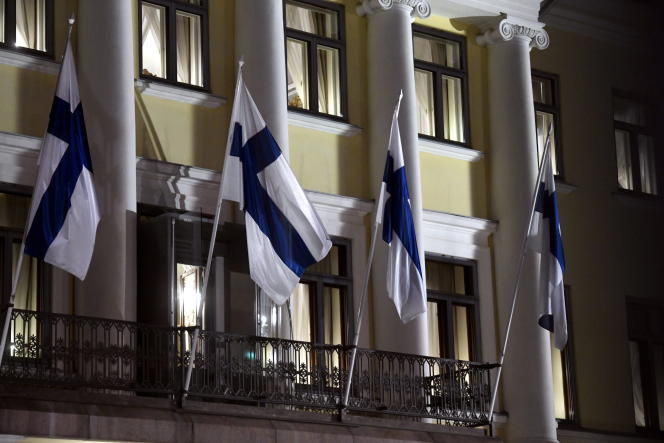Appointment was given, at the end of May, at the European Center of Excellence for the Fight against Hybrid Threats (Hybrid Coe), in Helsinki, on the floors of an ordinary building, in the heart of the Finnish capital. In a large room, several tables have been grouped together to accommodate five teams. The first, the “whites”, organizes the exercise. The “reds” – disinformation experts – will play the “bad guys” for two days: first Russia, then China. Finally, the “greens” actually form three teams: the international institutions, represented by officials from the European Union (EU) and NATO; the media, embodied by Finnish journalists; influencers and trolls.
The exercise takes place online. For several hours, remotely, a sixth team, the “blues” – “strategic communications” officials in four EU and NATO member countries, whose names we are not allowed to mention -, will try to defuse fake disinformation campaigns, created on social networks by the “reds”, relying on the “greens”.
Positive messages, crude lies, manipulation, trolling… Nothing is off limits. It is up to the four countries participating in the training to do their best to impose their message, in the face of campaigns that are sometimes difficult to identify and whose aim is to create disorder. The starting point is the current world but, as the game progresses, the organizers add elements of international tension – which we cannot reveal either –, concocting a fairly realistic scenario.
For all four countries, the stressors increase, culminating in a Hybrid War situation: it becomes increasingly difficult to identify right from wrong and respond appropriately. “The power of hybrid activities is to cause you to overreact and make decisions that harm you, while benefiting the adversary,” comments Hanna Smith, director of research and analysis at the Hybrid Coe Center. For example, when a democracy begins to react like an authoritarian state, limiting freedoms. »
“No country is immune”
“The goal of the exercise is to raise awareness and provide participants with the opportunity to practice the best approaches to identifying and responding to misinformation in a safe environment,” says fellow training director Shiho Rybski. at Hybrid Coe. While armies are used to training and countries to testing their cyber defense capabilities, counter-disinformation exercises are still rare because “they are not easy to organize,” Rybski acknowledges.
More than ever, however, the Russian invasion of Ukraine has shown the role of disinformation as an instrument of hybrid warfare, the arsenal of which includes cyberattacks and destabilization campaigns of all kinds. According to international experts gathered in Helsinki at the end of May, Russia may be at the forefront, but China is not far behind and has a huge strike force.
Professor at the University of San Francisco and expert on the subject, Doowan Lee explains: “Chinese disinformation is more subtle, less easily detectable. The message is often positive. It promotes economic cooperation. While Russia does not seem to have a long-term agenda, China is trying to shape European countries to be friendly towards it and maintain economic relations. Its operations are more coordinated and they pose a far greater threat to the EU, as they aim to slowly erode European cohesion. »
In this context, “no country is immune”, acknowledges Mikko Salo, president of FaktaBaari, a Finnish fact-checking platform. But, he says, Finland is particularly well armed. It is no coincidence that the European Center of Excellence for Countering Hybrid Threats, which cooperates with the EU and NATO, was inaugurated in Helsinki in 2017. With its 1,340 km of borders with Russia, the small Nordic country of 5.5 million inhabitants has developed a certain resistance to the attempts at destabilization led by its neighbor.
“We are well prepared”
Thus, the Russian media Sputnik and RT have never managed to establish themselves there. No Finnish journalist wanted to work there and Finnish, a rare language, made it difficult to write articles, which were often full of errors. In Finland, the role of the school is also highlighted: media education begins at an early age and continues throughout schooling. “Students are taught to be critical thinkers and to check their sources,” says Mikko Salo, who finds, however, that social media now presents a huge challenge for teachers.
Another Finnish characteristic is the very high level of trust enjoyed by the local media – just over 80% for public broadcaster Yle, according to a survey carried out in March. For the past two years, the group’s journalists have taken courses on disinformation. “I think we’re well prepared, but we have to stay humble,” said Timo Huovinen, head of journalistic conduct and ethics at Yle. He knows what he’s talking about: in 2016, he witnessed the discredit campaign launched against his colleague, the journalist Jessikka Aro, following her investigation into a troll factory in Saint Petersburg, of which she made a book , Putin’s Trolls (untranslated).
Since the start of the Russian invasion of Ukraine, Yle has regularly published articles warning Finns of the risk of hybrid attacks. Various scenarios have been imagined and every incident is reported, from GPS network disruptions to airspace violations, to the cyberattack on the sites of the ministries of defense and foreign affairs on April 8, when the Ukrainian president , Volodymyr Zelensky, spoke by videoconference to Finnish parliamentarians.
Appointed in 2021 to the post of ambassador for the fight against hybrid threats, diplomat Liisa Talonpoika defends the principle of transparency: “If we don’t tell everything, people start to wonder what we are hiding from them. Then they begin to doubt and, finally, they no longer believe what you tell them. »
“There should also be mobilization at European level”
For the moment, and despite its application for NATO membership, Finland has not recorded an increase in hybrid operations. For Hanna Smith, “it’s because it takes a minimum of preparation to carry out actions. This requires mapping the vulnerabilities of society in advance. However, the Finns themselves did not know that they were going to join NATO three months ago. And then, she says, “it is very difficult to make the Russians believe, all of a sudden, that Finland has become an enemy of Russia or, worse, that it would constitute a threat, with its 5 .5 million inhabitants. »
However, Helsinki has no illusions about the future. In its latest security report, the government, led by Social Democrat Sanna Marin, believes that Finland is at risk of “become the target of exceptional, wide-ranging and multifaceted hybrid influence activities, both in the short and long term. term “. In the Ministry of Interior, the National Security Unit has been tasked with identifying vulnerabilities in society.
In addition to a major cyberattack, the Finnish authorities fear the instrumentalization of immigration by Moscow. Before Belarus sent thousands of migrants to the borders of Poland and Lithuania in the fall of 2021, Russia had already carried out a similar operation in northern Finland during the winter of 2015-2016. At the end of April, the government presented a draft amendment to the asylum law. In particular, it plans to process applications in the accelerated procedure, at the border, in the event of a massive influx of refugees.
But Finland may be preparing, “there should also be systematic mobilization at European level,” said Eero Kytömaa, security specialist at the Ministry of the Interior in Helsinki. Because, he recalls, “the goal of authoritarian regimes is to create a gap between Europeans, with narratives that oppose, for example, France, or Germany, to the countries of the East, and to us divide “.














